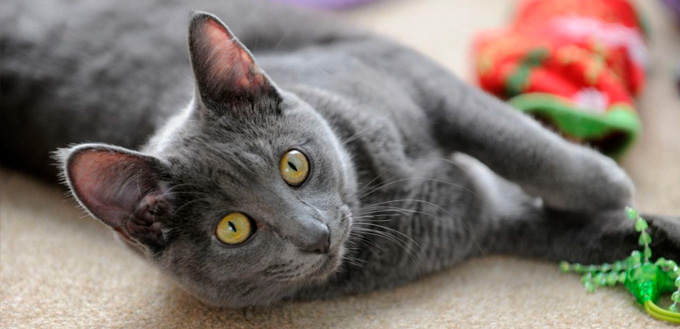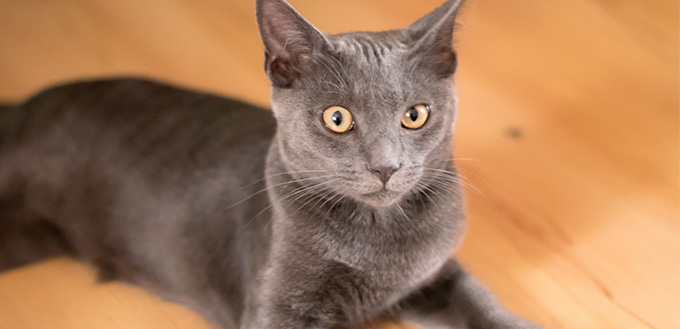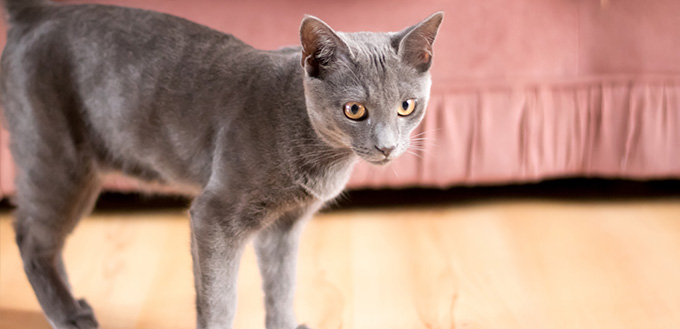As all cat lovers know, every cat is a little bit unique, and part of the joy of adopting one is getting to know them as new family member. Getting to know your cat starts with learning about their breed. Their breed is their history, their personality and their temperament, and it can help you to provide the best home possible for them. For a regal breed like the Korat cat, there is a lot of history to learn, and plenty of fun facts to help you bond with them, so let’s dive in and explore the Korat breed.

History of the Korat Cat
Although not one of the most famous or popular breeds of cat, the Korat cat has a very long and rich history that spans several continents and many centuries. If you want to know what to expect with your Korat, it is helpful to understand where they came from, who bred them, and why they were considered good companions. Cats have been everything, from mousers to status symbols, and understanding this past is important if you are going to form a strong bond.
The Korat Cat in Thailand
The Korat cat is a very old breed of cat that is considered the national cat of Thailand, unexpectedly beating out the world-famous Siamese. It was originally named the Mal-Ed, and is known in modern Thailand as the Si-Sawat. They are recorded in Thai literature as early as the 14th century, and were reportedly bred to bring good fortune to their owners, possibly due to the beautiful and magical appearance of their blue-grey coats.
Cats have a deep history in Thailand from books called tamra maew full of poems about the animal to a 19th century formal categorization of the 17 luckiest cats, known as The Smud Khoi of Cats, which, of course, features the Korat. Due to this link between the Korat cat, luck and luxury, they are predominantly owned by the upper classes.
This breed of cat is so steeped in tradition that it is seen as a cultural taboo to buy one for yourself, even in modern day Thailand. If you want a Korat, you better hope that you receive one as a gift. Their association with luck and luxury has made the Korat cat a common wedding gift in upper class marriages. It is hoped that the cat will bring the young couple good fortune, fertility, and wealth.
The Korat Cat in America
Jean L. Johnson is the woman credited with bringing the Korat Cat to the United States. As she explained in an open letter dated 1961, she lived with her husband in Thailand, then called Siam, after the war and during this time wanted to adopt a Siamese. After asking around, she found that none of her Siamese friends knew what she was talking about. The Siamese cat was not well known in Siam!
That was how she learned about the true Cat of Siam – the Korat cat, and she set about trying to adopt a pair. Due to their prestige, it took many more years before a pair of Korat cats were tracked down and sent to her in the United States, where she now lived. The male was called Nara and the female was called Dara. This was how the first pair of Korat cats arrived in 1959.
Although Johnson set about breeding her pair, the US still has a small gene pool of Korat cats, and their reverence in Thailand also makes importing them to broaden this gene pool a challenge. Luckily, like many cultures, cat breeds in Thailand are primarily categorized using the color of their fur. This means they can be outcrossed in breeding programs.
This is exactly what Johnson did to avoid inbreeding in the late 1950s. She bred each of her Korat cats with her blue pont Siamese cats and then, later, bred the Korat cats of each litter, distinguished by their blue-grey coats, with one another. Although many breeders have followed suit, the Korat breed is still rare in Thailand, the United States and all around the world.
The noble and luxurious history of the Korat in Thailand has continued here in the US as they have become a popular show cat. Hindered by their rarity, they have yet won Best Cat, but those that are entered often place highly in many prestigious competitions, including at national level.

Quick Facts About the Korat Cat
As we’ve already mentioned, history is very important, but a cat is also so much more than their past, so how else can we get to know the Korat Cat? There are all sorts of interesting things that define and differentiate one cat breed from another. Here are some quick fire facts about the breed that should give you a broader picture of these beautiful and affectionate companions.
- The Korat’s English name comes from the region where it is thought the cat was first bred, the Korat region.
- Their Thai name, Si-Sawat, comes from their coat and literally means ‘greyish-blue’, while ‘Sawat’ also means ‘prosperity’.
- The status of the Korat cat in Thailand allows for many additional myths and superstitions, such as the presence of a striped tail denoting a particularly lucky Korat.
- It is thought that the Siamese cat wrongfully became known as the national cat of Siam due to King Rama V who presented the seal point Siamese to an English consul as an emblem of his country to avoid having to give away any of his beloved Korats.
- As only the blue-grey colors of Korats are considered Korats, other, rarer colors have been given their own names, such as the lilac colored ‘Thai Lilac’ and the ‘Thai Blue Point’, which has a coat similar to the Siamese cats.
Things You Should Know
Getting to know your cat’s breed is an important part of being a pet parent, but there is also a lot of other basic information that is necessary for providing a high quality of life for a cat. You must care for their health, their food, their training, and many other aspects of their well being. So, last but not least, here is the essential information that you need if you are caring for a Korat cat. You can use it as a helpful beginner’s guide
Health
There are a few genetic illnesses that can plague cats as a species, and we recommend reading up on them before you make any adoption. As well as this, cats can also be prone to falling ill with certain disease or conditions. However, when it comes to the Korat cat, there is one condition that you must be particularly aware of.
Gangliosidosis is a genetic condition that is all too common in the Korat breed. This condition is caused when an animal’s body does not produce a very necessary enzyme that allows them to metabolize fats. The fats, called gangliosides, then accumulate to cause difficulty walking, tremors, seizures and paralysis. Unfortunately, by 10 months old, it is fatal.
It comes in two forms, called GM-1 and GM-2, but luckily, scientists have found the gene that carries the condition, so it can be tested for very easily. It is normal for a professional breeder to carry out such tests before breeding their animals, and they should be able to provide a written guarantee that your Korat is healthy.
A good piece of advice is to ask your breeder about Gangliosidosis before you buy your Korat cat. If your breeder does not recognize the health concern, it is very likely that they are not experienced enough with this breed, and may not have done the appropriate health tests. A good breeder will provide a written health guarantee as standard.
A normal, healthy Korat kitten should live a long life. Many live up to 19 years old, so they can be quite a commitment. Just as you should find an experienced breeder, try to find a vet that has experience treating the Korat breed as this should ensure your cat is offered the best health care possible. This also applies to working with a behaviorist, as the Korat’s cool, distant personality can be a unique experience.
Feeding
Another all-too-common health issue among all cats is obesity. It is fundamental to your Korat cat’s happiness and health that you feed them correctly. They need a balanced carnivorous diet with a wide variety of essential nutrients.
Related Post: Best Cat Food for Weight Loss
The best thing for your cat is to consult with a vet about how much they should be eating. As with any cat, the Korat can vary. Size, gender, personality, age or lifestyle can all impact how much you should feed your Korat. Energetic, growing kittens will need more protein and calories, for example, and small Korats shouldn’t eat the same amount as particularly large Korats.
In terms of their likes and dislikes, however, you’ll be pleased to hear that Korats, on the whole, do not have specific tastes. Although, individual Korats may have certain preferences that will impact how they react to some tastes. Prioritize their nutrition by providing them with high-quality, protein-rich food, but you can also experiment among different brands and tastes to see which they prefer.
Related Posts: Best Dry Cat Food and Best Wet Cat Food

Care
Other than their genetic predisposition for gangliosidosis, your Korat does not require special care as some other breeds might. Vaccinations, parasite control and annual health checks are, as always, essential. You can keep your Korat both indoors or outdoors, although their rarity and prestige usually means owners prefer to keep them as indoor cats.
Related Posts: Best Litter Boxes For Cats and Best Self-Cleaning Litter Boxes
You must provide them with a litter box that you clean out at least once a week, as well as a bed and plenty of toys. As an intelligent cat, the Korat will enjoy mentally challenging toys, such as puzzle boxes. You must also ensure they get enough exercise, either through access to a garden, or by taking them on walks with a leash. Not all Korats will like walking on a leash, or spending time outside, so make sure you also schedule a regular, energetic play time.
Related Post: Best Interactive Cat Toys
Grooming
With their short, fine hair, grooming a Korat cat is, thankfully, not too difficult. If you have previously owned a cat, you are probably familiar with how best to groom them, but for new owners, or as a helpful reminder, here are the basics of grooming a Korat:
- Start grooming practices as early as possible so that your kitten gets used to them
- Brush their coat twice a week
- Increase this brushing to three, or even four, times a week in spring when their coat sheds
- Trim their nails whenever they risk damaging your furniture or pose a risk of scratching
- Clean their ears out when they look dirty using a veterinary recommended, gentle cleanser
- Brush their teeth several times a week, if not every day, with a veterinary recommended toothpaste
Related Posts: Best Cat Ear Cleaner, Best Cat Toothbrushes, Best Cat Toothpaste and Best Cat Nail Clippers
Temperament
The Korat cat’s rich history of luxury and wealth has made this breed a cat that you will want to spoil, and who likes to be treated well. They have regal personalities, and will probably fancy themselves the top of the family hierarchy, so be prepared to sometimes feel a bit like a servant.
Being traditionally gifted in pairs, the Korat does tend to gravitate towards its own kind, but, although perhaps a little stuck up, they can get along well with other pets and are affectionate with their humans. In fact, they can be a little clingy and do not do well being left on their own for long periods of the day.
Although they probably wouldn’t like to admit it, this cat has a bit of a sweet, vulnerable side and will follow you around whenever you are home, vying for a bit of a cuddle and comfort. They also won’t like lots of noise or activity, preferring environments that are like they are – calm. This calmness makes them good with children, so they can be a great addition to a family.
Their calm attitudes also extend to their vocalizations. One of the most notable differences between their Siamese cousins is that they are much quieter, preferring to use their body language to express themselves. Rather than call to you for food, the Korat cat will come to you and nudge you until you give them what they want.
Despite their slightly timid and peaceful natures, they can be very energetic and playful. Coupled with their intelligence, this makes them great cats for training. They will enjoy puzzle toys and challenges, so use rewards to encourage this side of them from an early age.





